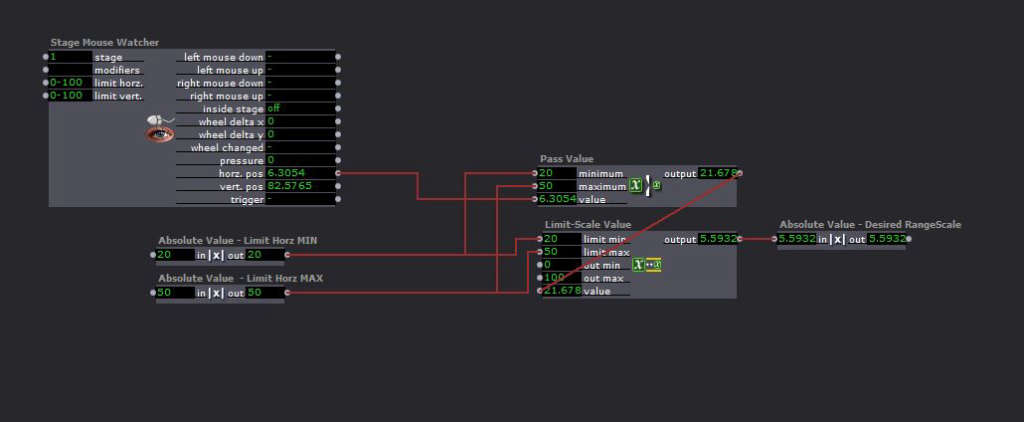[SOLVED] Stage Scaling doesn't effect Stage Mouse Watcher?
-
Hi, I noticed that the Stage Scaling actor doesn't have any effect on the mouse position of the Stage Mouse Watcher actor. Is there any other way to achieve this?
-
@wijnand said:
Hi, I noticed that the Stage Scaling actor doesn't have any effect on the mouse position of the Stage Mouse Watcher actor. Is there any other way to achieve this?
Hiya,
I'm not entirely sure what you're asking, but if you're trying to scale the values of the Stage Mouse Watcher's position you could adjust the "limit horiz." and "limit vert." inputs to see if that does what you want.
If you're more concerned with scaling the values that the Stage Mouse Watcher outputs, you could attach Limit Scale Value actors to the "horz. pos" and "ver. pos" outputs or change the scale of those outputs directly by changing the min and the max.
If you explain a bit more about what you're trying to do I may be able to be more useful.
Best wishes,
Woland
-
Hi Woland, thanks for your elaborate answer, but it's not what I'm asking for. I'll try to be a bit more clearer:
I set the 'limit horz.' and 'limit vert.' of the Stage Mouse Watcher, for example at: 10-18 and 49-64 respectively. Now if I change the Stage Scaling's 'horz size' and 'vert size' from 100 to 70, it doesn't have any effect on the 'limit horz' and 'limit vert' of the Stage Mouse Watcher. I had assumed that the percentages of the Stage Mouse Watcher's 'limit horz' and 'limit vert' would be influenced by the Stage Scaling's 'horz size' and 'vert size'. But this doesn't seem to work. Would there be any other way to scale the 'limit horz' and 'limit vert' of the Stage Mouse Watcher?
Kind regards,
Wijnand
-
Stage Scaling : "Determines how the image will be scaled when rendered to a stage. ..."
This actor doesn't actually change the stage, it changes the rendering of images to the stage.
Would would have to scale the values received from the Stage Mouse Watcher in relation to any rendering scaling made in the Stage Scaling actor to make the points align.
-
Thanks for your message. I now understand what Stage Scaling does.
There doesn't seem to be a way to scale the 'limit horz' and 'limit vert'. Scaling the output of the Stage Mouse Watcher (by using limit scale value) doesn't change the input of the Stage Mouse Watcher.
I consider this to be unsolved.
-
I've been struggling to understand what you are trying to achieve, but i think i have it: you want to be able to change the Limit Horiz and Limit Vert values by connecting other actors to them so that the limits can change dynamically. Is this right?
In which case, i don't think there's an easy answer, but there may be a way around it. @Woland , @DusX - any ideas?
-
These inputs use a 'range' type that is not commonly used in Isadora. The manual states that these accept a pair of Integers, but I have not yet been able to make this work.
The manual also says that sending a single Int (eg: 5) will make the range Int-Int (eg 5-5) so no range.
I would suggest leaving these ranges set to 0-100, and then limit your input range (I would use a 'Pass Value' actor) that then feed to a limit scale value actor.
See image:
I think this might get your the values you are after.
I need to investigate these 'range' types more. For now it seems you can only type in a range, and no other entry method is available. -
@dbini this indeed is exactly what I'm trying to achieve.
@DusX Thanks for thinking with me, really appreciated. I see what you're trying to do there. The pass value makes it possible to change the value of the output, but still doesn't change the value of the input and there are no other 'mouse' actors to work with where the output could go to. The 'range' type seems to make it impossible to use the input as a variable. If the limit horz would be split into two variables (1. limit horz start, 2 limit horz end), both accepting integers, it would make it easier to deal with this problem.
For now as a workaround I'm making two distinct versions of the same setup to test with.
-
the Stage Mouse Watcher is basically taking data from the mouse position (0 through 100 as a percentage of the distance across the stage) and outputting it as a number between 0 and 100. So processing the output of this has the same effect as processing the input. Ryan's patch does exactly what you need it to do and has the same effect as changing the Limits of the input to the Actor - setting a minimum and maximum range for the mouse position, and outputting the results as a number between 0 and 100. you would just need to do the same for the vertical position.